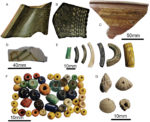An excavation at the ancient port of Mantai in Sri Lanka has unearthed what is likely to be the oldest clove in the world.
Located on the northwest coast of Sri Lanka, Mantai was a pivotal hub of trade between the Arabian Sea, the Bay of Bengal, the east and west coasts of India and the interior of Sri Lanka from the time it was founded around 200 B.C. Merchant ships stopped at the port in the middle of the Indian Ocean laden with goods from the East (China, southeast Asia islands and mainland) and West (Europe, Africa, Middle East), part of a complex network of trade routes that linked the ancient world for the duration of Sri Lanka’s Anuradhapura Kingdom and beyond, from the middle of the 1st millennium B.C. through the 13th century.
 Archaeological exploration of Mantai was still in its infancy when it was brusquely interrupted by civil war in 1983. In the three seasons of excavations, archaeologists had unearthed a rich assortment of ceramics and semi-precious stone beads from India, Arabia, the Mediterranean and China. Much of the context of those finds was lost or damaged during the war, as were the records detailing the stratigraphy of the site.
Archaeological exploration of Mantai was still in its infancy when it was brusquely interrupted by civil war in 1983. In the three seasons of excavations, archaeologists had unearthed a rich assortment of ceramics and semi-precious stone beads from India, Arabia, the Mediterranean and China. Much of the context of those finds was lost or damaged during the war, as were the records detailing the stratigraphy of the site.
 Excavations resumed in 2009-2010. With so much ground to cover and not much time to cover it, the team of archaeologists from the Sri Lankan Department of Archaeology, the European Research Council-funded Sealinks Project and the University College London Institute of Archaeology focused on an in-depth investigation of the material in a single very deep trench south of the central occupation mound. The trench was 10 x 10 feet wide and a whopping 33 feet deep, reaching middle Holocene layers. The goal was to recover a multitude of small finds from ceramics to organic remains to fossilized particles of plant tissue that would allow the team to establish a series of precise radiocarbon dates to serve as a much-needed baseline for future excavations.
Excavations resumed in 2009-2010. With so much ground to cover and not much time to cover it, the team of archaeologists from the Sri Lankan Department of Archaeology, the European Research Council-funded Sealinks Project and the University College London Institute of Archaeology focused on an in-depth investigation of the material in a single very deep trench south of the central occupation mound. The trench was 10 x 10 feet wide and a whopping 33 feet deep, reaching middle Holocene layers. The goal was to recover a multitude of small finds from ceramics to organic remains to fossilized particles of plant tissue that would allow the team to establish a series of precise radiocarbon dates to serve as a much-needed baseline for future excavations.
 Among the organic remains recovered from the deep trench are spices that were some of the most valuable trade goods that moved across the East-West routes through Sri Lanka, notably cloves and black peppercorns.
Among the organic remains recovered from the deep trench are spices that were some of the most valuable trade goods that moved across the East-West routes through Sri Lanka, notably cloves and black peppercorns.
Only a handful of cloves have previously been recovered from archaeological sites, including these from France, for example – other archaeological evidence for cloves, such as pollen from cess pits in the Netherlands, only dates from 1500AD onwards – and there are no examples from South Asia.
Earlier finds of clove have been reported from Syria – but these have since largely been discredited as misidentifications. The clove from Mantai was found in a context dating to 900-1100AD, making this not only the oldest clove in Asia – but we think the oldest in the world.
We also found eight grains of black pepper at Mantai, plus a further nine badly preserved grains that we think are probably black pepper too. The earliest are dated to around 600AD, the time when international maritime trade became increasingly large and well established across Asia, Africa and Europe.
Cloves are not native to Sri Lanka. They were grown in the Maluku Islands, more than 4000 miles east of Sri Lanka by sea, and traded to Europe where they were highly prized from Roman times onward. They were used as spices to enhance the flavor of food and drink, but also widely used for medicinal purposes and personal hygiene, like to combat the heartbreak of halitosis. Black pepper was less rare and less distant, but still so desirable that it was known as “black gold” at the apex of the maritime spice trade from the 16th century through the 19th. The peppercorns found at Mantai probably came from the Western Ghats of India.
From the 16th century, Sri Lanka (then known as Ceylon) was colonised by various European powers, from the Portuguese (1500s-1600s) to the Dutch (1600s-late 1700s) to the British (late 1700s-1948). They were all drawn by the island’s profitable trade in spices – although the British turned the fledgling coffee industry there into an incredibly lucrative tea trade which is still important to the island’s economy to this day.
But, whether or not the cloves we unearthed at Mantai turn out to be the oldest in existence, the presence of the spice at this 2,000-year-old site is solid evidence of the ancient spice trade that existed long before these wars of conquest.